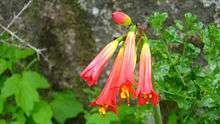Eustephieae
| Eustephieae | |
|---|---|
 | |
| Eustephia coccinea | |
| Scientific classification | |
| Kingdom: | Plantae |
| Clade: | Angiosperms |
| Clade: | Monocots |
| Order: | Asparagales |
| Family: | Amaryllidaceae |
| Subfamily: | Amaryllidoideae |
| Tribe: | Eustephieae Hutch. [1] |
| Type genus | |
| Eustephia Hutch. | |
| Genera | |
|
see text | |
Eustephieae is a tribe (in the family Amaryllidaceae, subfamily Amaryllidoideae), where it forms part of the Andean clade, one of two American clades.[2]
Taxonomy
Phylogeny
This tribe was resurrected from the Stenomesseae in 1995 by Meerow.[3] The placement of Eustephieae within subfamily Amaryllidoideae is shown in the following cladogram, where this tribe is shown as a sister group to the remainder of the tetraploid Andean clade.[4]
| Cladogram: Tribes of subfamily Amaryllidoideae | |||||||||||||||||||||||||||||||||||||||||||||||||||||||||||||||||||||||||||||||||||||||
| |||||||||||||||||||||||||||||||||||||||||||||||||||||||||||||||||||||||||||||||||||||||
Subdivision
Four genera:
Distribution
The Eustephieae for the southern limit of the Andean clade. They are found in Peru in the southern Andes, and the northern Andes of Argentina, Bolivia and Chile. This is distinct from the central Andean distribution of the remainder of the parent clade.[4]
References
- ↑ Fam.Fl.Pl.2:130.20 Jul 1934
- ↑ Vigneron 2008.
- ↑ Meerow 1995.
- 1 2 Meerow et al. 2000b.
Bibliography
- Meerow, Alan. Towards a phylogeny of the Amaryllidaceae. pp. 169–179., in Rudall et al. (1995)
- Müller-Doblies, U.; Müller-Doblies, D. (1996). "Tribes and subtribes and some species combinations in Amaryllidaceae J St Hil R Dahlgren & al. 1985". Feddes Repertorium. 107 (5–6): S.c.1–S.c.9.
- Meerow, AW; Snijman, DA. Amaryllidaceae. pp. 83–110. doi:10.1007/978-3-662-03533-7_11., in Kubitzki (1998). (additional excerpts)
- Meerow, Alan W.; Snijman, Deirdre A. (2006). "The never-ending story: multigene approaches to the phylogeny of Amaryllidaceae". Aliso. 22: 355–366. Retrieved 25 January 2015.
- Vigneron, Pascal (2008). "Amaryllidaceae". Amaryllidaceae.org (in French). Retrieved 23 October 2014.
- Stevens, P.F. (2001–2012), Angiosperm Phylogeny Website: Amaryllidoideae
- Rudall, P.J.; Cribb, P.J.; Cutler, D.F.; Humphries, C.J., eds. (1995). Monocotyledons: systematics and evolution (Proceedings of the International Symposium on Monocotyledons: Systematics and Evolution, Kew 1993). Kew: Royal Botanic Gardens. ISBN 978-0-947643-85-0. Retrieved 14 January 2014.
- Kubitzki, K., ed. (1998). The families and genera of vascular plants. Vol.3. Berlin, Germany: Springer-Verlag. ISBN 3-540-64060-6. Retrieved 14 January 2014.
- Meerow, A.W.; Fay, M.F.; Guy, C.L.; Li, Q.-B.; Zaman, F.Q.; Chase, M.W. (1999). "Systematics of Amaryllidaceae based on cladistic analysis of plastid rbcL and trnL-F sequence data". Am. J. Bot. 86 (9): 1325–1345. doi:10.2307/2656780. JSTOR 2656780. PMID 10487820.
- Meerow, A.W.; Guy, C.L.; Li, Q.-B.; Yang, S.-L. (2000). "Phylogeny of the American Amaryllidaceae Based on nrDNA ITS Sequences" (PDF). Systematic Botany. 25 (4): 708–726. doi:10.2307/2666729. Retrieved 25 January 2015.
- "Amaryllidaceae: A taxonomic tool for the Amaryllidaceae of the world". eMonocot.
External links
| Wikimedia Commons has media related to Eustephieae. |
| Wikispecies has information related to: Eustephieae |